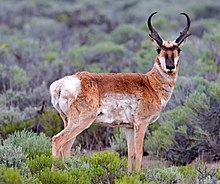| Pronghorn Temporal range: Early Pleistocene – Recent
| |
|---|---|

| |
| Adult male pronghorn in Oregon | |

| |
| Adult female pronghorn in Wyoming | |
| Scientific classification | |
| Domain: | Eukaryota |
| Kingdom: | Animalia |
| Phylum: | Chordata |
| Class: | Mammalia |
| Order: | Artiodactyla |
| Family: | Antilocapridae |
| Subfamily: | Antilocaprinae |
| Tribe: | Antilocaprini |
| Genus: | Antilocapra |
| Species: | A. americana[1]
|
| Binomial name | |
| Antilocapra americana[1] (Ord, 1815)
| |
| Subspecies | |
|
A. a. americana | |

| |
| Range of the pronghorn | |
The pronghorn (UK: /ˈprɒŋhɔːrn/, US: /ˈprɔːŋ-/)[4] (Antilocapra americana) is a species of artiodactyl (even-toed, hoofed) mammal indigenous to interior western and central North America. Though not an antelope, it is known colloquially in North America as the American antelope, prong buck, pronghorn antelope and prairie antelope,[5] because it closely resembles the antelopes of the Old World and fills a similar ecological niche due to parallel evolution.[6] It is the only surviving member of the family Antilocapridae.[7]
During the Pleistocene epoch, about 11 other antilocaprid species existed in North America, many with long or spectacularly-twisted horns.[8] Three other genera (Capromeryx,[9][10] Stockoceros[11][12] and Tetrameryx[13]) existed when humans entered North America but are now extinct.
The pronghorn's closest living relatives are the giraffe and okapi.[14] The Antilocaprids are part of the infraorder Pecora, making them distant relatives of deer, bovids, and moschids.
The pronghorn is the fastest land mammal in the Americas, with running speeds of up to 88.5 km/h (55 mph). It is the symbol of the American Society of Mammalogists.[15]
- ^ Grubb, P. (2005). "Order Artiodactyla". In Wilson, D.E.; Reeder, D.M (eds.). Mammal Species of the World: A Taxonomic and Geographic Reference (3rd ed.). Johns Hopkins University Press. pp. 671–2. ISBN 978-0-8018-8221-0. OCLC 62265494.
- ^ IUCN SSC Antelope Specialist Group (2017) [errata version of 2016 assessment]. "Antilocapra americana". IUCN Red List of Threatened Species. 2016: e.T1677A115056938. doi:10.2305/IUCN.UK.2016-3.RLTS.T1677A50181848.en. Retrieved 31 August 2020.
- ^ "Appendices | CITES". cites.org. Retrieved 2022-01-14.
- ^ Wells, John C. (2008), Longman Pronunciation Dictionary (3rd ed.), Longman, ISBN 9781405881180
- ^ Caton, J. D. (1876). "The American Antelope, or Prong Buck". The American Naturalist. 10 (4): 193–205. doi:10.1086/271628. JSTOR 2448724.
- ^ Farb, Peter (1970). Ecology. Time Life Books. pp. 126, 136
- ^ Hawes, Alex (November 2001). "Pronghorns - Survivors of the American Savanna". Zoogoer. Smithsonian. Archived from the original on 2009-07-13. Retrieved 2015-11-21.
- ^ Smithsonian Institution. North American Mammals: Pronghorn Antilocapra americana Archived 2016-01-22 at the Wayback Machine
- ^ "Capromeryx furcifer Matthew 1902". Paleobiology Database. Archived from the original on 2023-10-04. Retrieved 2015-11-21.
- ^ "Capromeryx minor Taylor 1911". Paleobiology Database. Archived from the original on 2023-10-04. Retrieved 2015-11-21.
- ^ "Stockoceros conklingi Stock 1930". Paleobiology Database. Archived from the original on 2022-05-26. Retrieved 2015-11-21.
- ^ "Stockoceros onusrosagris Roosevelt and Burden 1934". Paleobiology Database. Archived from the original on 2022-05-27. Retrieved 2015-11-23.
- ^ "Tetrameryx shuleri Lull 1921". Paleobiology Database. Archived from the original on 2022-05-22. Retrieved 2015-11-21.
- ^ Upham, N.S.; Esselstyn, J.A.; Jetz, W. (2019). "Inferring the mammal tree: Species-level sets of phylogenies for questions in ecology, evolution, and conservation". PLOS Biology. 17 (12): e3000494. doi:10.1371/journal.pbio.3000494. PMC 6892540. PMID 31800571. See Fig. S10 in Supplementary Information.
- ^ "About ASM | American Society of Mammalogists". www.mammalsociety.org. 2011-03-16. Retrieved 2019-10-31.
Cite error: There are <ref group=note> tags on this page, but the references will not show without a {{reflist|group=note}} template (see the help page).
